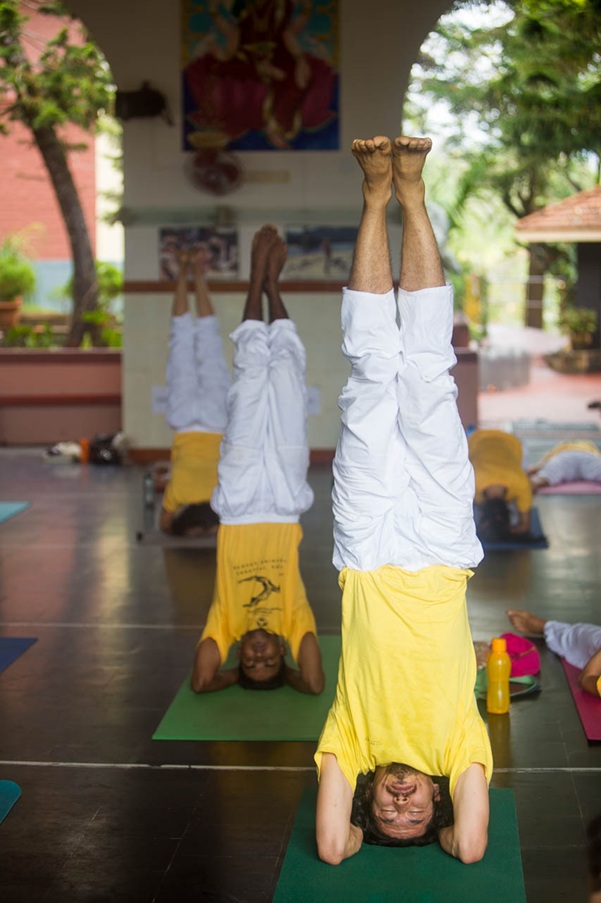by Sivananda Yoga Vedanta Dhanwantari Ashram
Sirsasana, is a powerful inversion asana that brings both body and mind into harmony. In this pose, the body is gently balanced upside down on the crown of the head and forearms, inviting a sense of stillness, clarity, and focus. Practicing Sirsasana is known to improve blood circulation, sharpen concentration, and cultivate inner balance. Because this is an advanced posture, it is recommended to learn and practice Sirsasana under the guidance of a qualified yoga teacher, ensuring both safety and alignment.
Steps
From the Child’s pose, sit up on the heels, knees together. Place ach hand on the opposite elbow, measuring the distance. Bring the elbows to the ground under the shoulders.
Bring the hands together so that the arms form a tripod on the ground, interlocking the fingers.
Place the head on the ground with the back of the head against the hands. Raise the hips. (Make sure that the elbows are stationary).
Walk the feet forward towards the head. Keep the hips up and knees straight.
Bend the knees in towards the chest. Bring the heels up to the buttocks.
Straighten the back, making sure that the spine retains its natural curve. Be able to balance in this position for at least 30 seconds before going further.
Keeping the knees bent and together, slowly straighten the hips until the bent knees are pointing towards the ceiling.
Straighten the knees.
Holding the position:
Start with 15 seconds, gradually increasing the time. Optimum time is 5 – 10 minutes on a daily basis. While in the position make the breath smooth and rhythmic.
To come out of the position:
Bend the knees, bringing them into the chest.
Bend the hips bringing the feet to the floor.
Relax in the Child’s Pose before lifting head off the ground.
Do not practise the Headstand if you:
Have high blood pressure.
Suffer from Glaucoma.
Are 4 or more months pregnant.
Have been advised not to by your doctor.
Benefits of the Headstand
Physical benefits
By inverting the body and keeping it in a straight line, the pull of gravity is counteracted. The heart needs to pump the blood with only enough force for it to reach the toes; gravity will help to return it to the heart.
People who practise Sirsasana on a regular basis tend to have slow rates of respiration and heartbeat. This indicates that the respiratory and circulatory systems are strong and flexible.
Inverting the body enhances deep breathing, bringing an increased oxygen supply to the brain and sympathetic nervous system.
As a result of this rich supply of nutrients, all body functions are toned and enhanced.
Disorders of the nerves, eyes, ears, nose and throat are improved.
Persons suffering from varicose veins will feel relief in the Headstand as stagnant blood will drain from the lower extremities. Sirsasana is also a remedy for renal colic and stubborn constipation.
Pressure is relieved on the lumbar and sacral areas of the lower back.
The Headstand combats dropped stomach and nervous or hepatic asthma.
The Headstand is one of the most powerful Asanas for body and mind, a virtual panacea for all human ills.
Mental Benefits
Memory and intellectual capacity are increased.
Improved concentration; the Headstand is particularly beneficial to people who need strong powers of concentration in their work: students, politicians, artists, scientists and writers.
Improved sensory faculties (eyesight, hearing).
The person who practices the Headstand on a regular basis will rarely suffer from nervous disorders.
